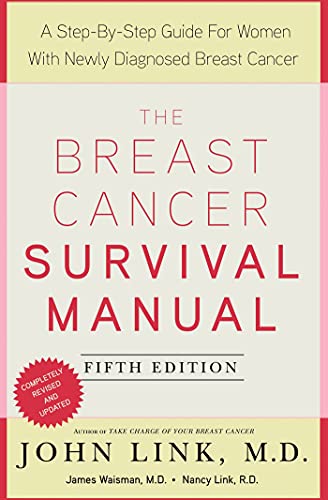Items related to The Breast Cancer Survival Manual, Fifth Edition: A...
The Breast Cancer Survival Manual, Fifth Edition: A Step-by-Step Guide for Women with Newly Diagnosed Breast Cancer - Softcover

Synopsis
The updated edition of the essential resource for the 250,000 women diagnosed with breast cancer each year
Breast cancer is the leading cause of death in women from thirty-five to fifty-four years of age, and few things are as terrifying and confusing as a diagnosis of this disease. The fifth edition of The Breast Cancer Survival Manual is a concise, information-packed guide that is newly revised to contain all of the latest findings to help the woman facing treatment feel informed and empowered. John Link, M.D., a pioneer developer of Breastlink Medical Group in Southern California includes the most current medical advice on
• Tamoxifen, Herceptin, and other chemotherapy options
• The growing importance of HER2 oncogene testing
• Clinical research trials under way that could broaden treatment options
• The role of preventive drugs and prophylactic mastectomy for those with high genetic risk
• Sentinel lymph node sampling, a method of local control soon to become standard
Of course, all of the basic information included in the previous editions―the nature and biology of breast cancer, choosing a treatment team, managing side effects, and optimizing medication―are here as well, making this the best book of its kind on the market.
"synopsis" may belong to another edition of this title.
About the Author
Dr. John Link is recognized as one of the world’s leading breast cancer specialists, and is the pioneer developer of Breastlink Medical Group in Southern California. He is the author of The Breast Cancer Survival Manual.
"About this title" may belong to another edition of this title.
FREE shipping within U.S.A.
Destination, rates & speedsSearch results for The Breast Cancer Survival Manual, Fifth Edition: A...
The Breast Cancer Survival Manual, Fifth Edition: A Step-by-Step Guide for Women with Newly Diagnosed Breast Cancer
Seller: BooksRun, Philadelphia, PA, U.S.A.
Paperback. Condition: Good. Fifth Edition, Revised. It's a preowned item in good condition and includes all the pages. It may have some general signs of wear and tear, such as markings, highlighting, slight damage to the cover, minimal wear to the binding, etc., but they will not affect the overall reading experience. Seller Inventory # 0805094458-11-1
Quantity: 1 available
The Breast Cancer Survival Manual, Fifth Edition: A Step-by-Step Guide for Women with Newly Diagnosed Breast Cancer
Seller: World of Books (was SecondSale), Montgomery, IL, U.S.A.
Condition: Acceptable. Item in acceptable condition including possible liquid damage. As well, answers may be filled in. Lastly, may be missing components, e.g. missing DVDs, CDs, Access Code, etc. Seller Inventory # 00024884512
Quantity: 1 available
The Breast Cancer Survival Manual, Fifth Edition: A Step-by-Step Guide for Women with Newly Diagnosed Breast Cancer
Seller: World of Books (was SecondSale), Montgomery, IL, U.S.A.
Condition: Very Good. Item in very good condition! Textbooks may not include supplemental items i.e. CDs, access codes etc. Seller Inventory # 00092051222
Quantity: 1 available
The Breast Cancer Survival Manual, Fifth Edition: A Step-by-Step Guide for Women with Newly Diagnosed Breast Cancer
Seller: Orion Tech, Kingwood, TX, U.S.A.
paperback. Condition: Good. Seller Inventory # 0805094458-3-31858963
Quantity: 1 available
The Breast Cancer Survival Manual, Fifth Edition: A Step-by-Step Guide for Women with Newly Diagnosed Breast Cancer
Seller: Gulf Coast Books, Cypress, TX, U.S.A.
paperback. Condition: Good. Seller Inventory # 0805094458-3-34911365
Quantity: 1 available
The Breast Cancer Survival Manual, Fifth Edition: A Step-by-Step Guide for Women with Newly Diagnosed Breast Cancer
Seller: Gulf Coast Books, Cypress, TX, U.S.A.
paperback. Condition: Fair. Seller Inventory # 0805094458-4-34551566
Quantity: 1 available
The Breast Cancer Survival Manual, Fifth Edition: A Step-by-Step Guide for Women with Newly Diagnosed Breast Cancer
Seller: Once Upon A Time Books, Siloam Springs, AR, U.S.A.
Paperback. Condition: Good. This is a used book in good condition and may show some signs of use or wear . This is a used book in good condition and may show some signs of use or wear . Seller Inventory # mon0000524532
Quantity: 1 available
The Breast Cancer Survival Manual, Fifth Edition: A Step-by-Step Guide for Women with Newly Diagnosed Breast Cancer
Seller: Wonder Book, Frederick, MD, U.S.A.
Condition: Very Good. Very Good condition. 5th edition. A copy that may have a few cosmetic defects. May also contain light spine creasing or a few markings such as an owner's name, short gifter's inscription or light stamp. Bundled media such as CDs, DVDs, floppy disks or access codes may not be included. Seller Inventory # W04E-03085
Quantity: 2 available
The Breast Cancer Survival Manual, Fifth Edition : A Step-By-Step Guide for Women with Newly Diagnosed Breast Cancer
Seller: Better World Books, Mishawaka, IN, U.S.A.
Condition: Good. 5th Edition. Former library book; may include library markings. Used book that is in clean, average condition without any missing pages. Seller Inventory # 940213-75
Quantity: 1 available
The Breast Cancer Survival Manual, Fifth Edition : A Step-By-Step Guide for Women with Newly Diagnosed Breast Cancer
Seller: Better World Books, Mishawaka, IN, U.S.A.
Condition: Good. 5th Edition. Used book that is in clean, average condition without any missing pages. Seller Inventory # 5105731-6
Quantity: 1 available
